Agile and Iterative Methodologies assignment
VerifiedAdded on 2021/05/31
|12
|2710
|197
AI Summary
Contribute Materials
Your contribution can guide someone’s learning journey. Share your
documents today.

Title Page
1
1
Secure Best Marks with AI Grader
Need help grading? Try our AI Grader for instant feedback on your assignments.
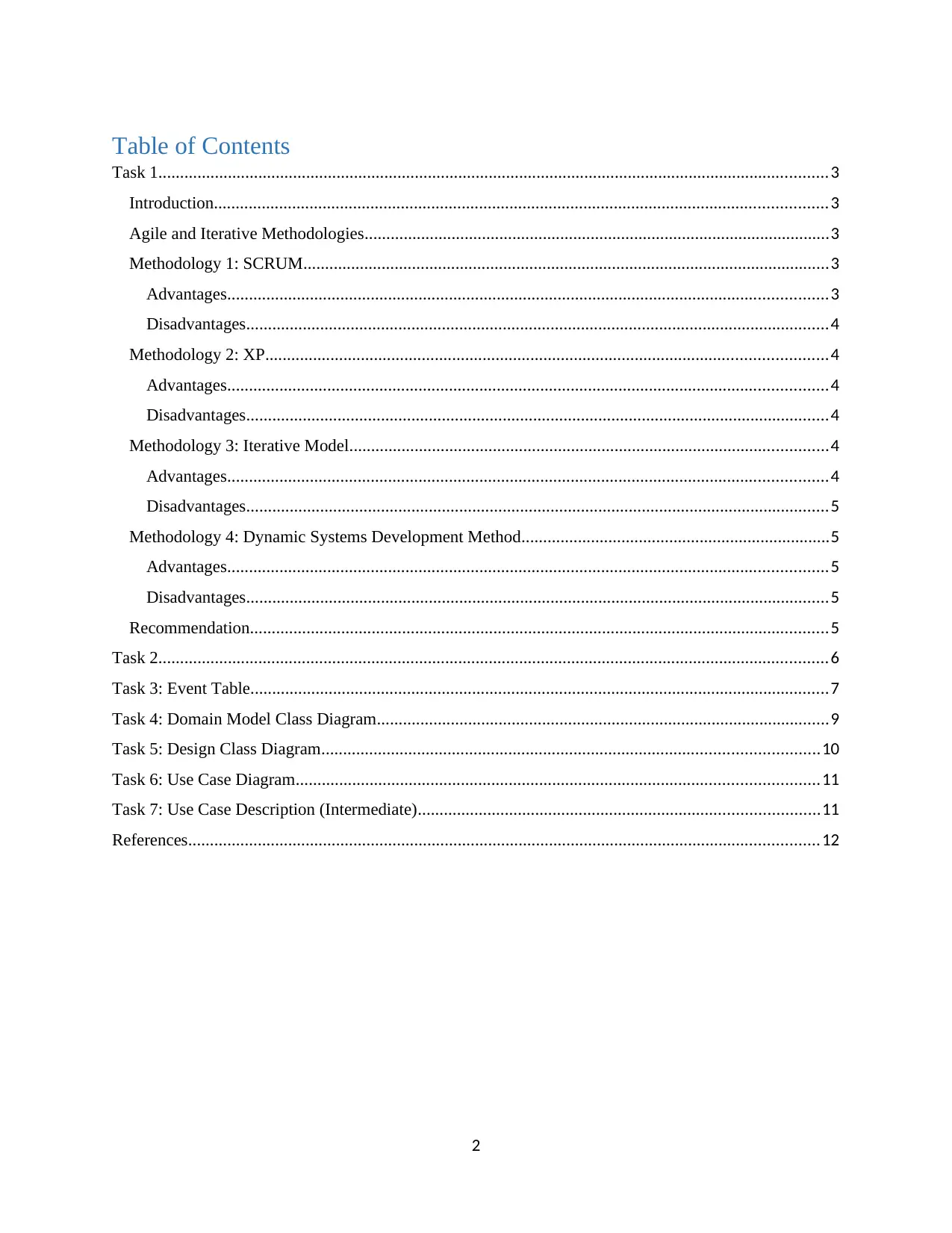
Table of Contents
Task 1..........................................................................................................................................................3
Introduction.............................................................................................................................................3
Agile and Iterative Methodologies...........................................................................................................3
Methodology 1: SCRUM.........................................................................................................................3
Advantages..........................................................................................................................................3
Disadvantages......................................................................................................................................4
Methodology 2: XP.................................................................................................................................4
Advantages..........................................................................................................................................4
Disadvantages......................................................................................................................................4
Methodology 3: Iterative Model..............................................................................................................4
Advantages..........................................................................................................................................4
Disadvantages......................................................................................................................................5
Methodology 4: Dynamic Systems Development Method.......................................................................5
Advantages..........................................................................................................................................5
Disadvantages......................................................................................................................................5
Recommendation.....................................................................................................................................5
Task 2..........................................................................................................................................................6
Task 3: Event Table.....................................................................................................................................7
Task 4: Domain Model Class Diagram........................................................................................................9
Task 5: Design Class Diagram..................................................................................................................10
Task 6: Use Case Diagram........................................................................................................................11
Task 7: Use Case Description (Intermediate)............................................................................................11
References.................................................................................................................................................12
2
Task 1..........................................................................................................................................................3
Introduction.............................................................................................................................................3
Agile and Iterative Methodologies...........................................................................................................3
Methodology 1: SCRUM.........................................................................................................................3
Advantages..........................................................................................................................................3
Disadvantages......................................................................................................................................4
Methodology 2: XP.................................................................................................................................4
Advantages..........................................................................................................................................4
Disadvantages......................................................................................................................................4
Methodology 3: Iterative Model..............................................................................................................4
Advantages..........................................................................................................................................4
Disadvantages......................................................................................................................................5
Methodology 4: Dynamic Systems Development Method.......................................................................5
Advantages..........................................................................................................................................5
Disadvantages......................................................................................................................................5
Recommendation.....................................................................................................................................5
Task 2..........................................................................................................................................................6
Task 3: Event Table.....................................................................................................................................7
Task 4: Domain Model Class Diagram........................................................................................................9
Task 5: Design Class Diagram..................................................................................................................10
Task 6: Use Case Diagram........................................................................................................................11
Task 7: Use Case Description (Intermediate)............................................................................................11
References.................................................................................................................................................12
2
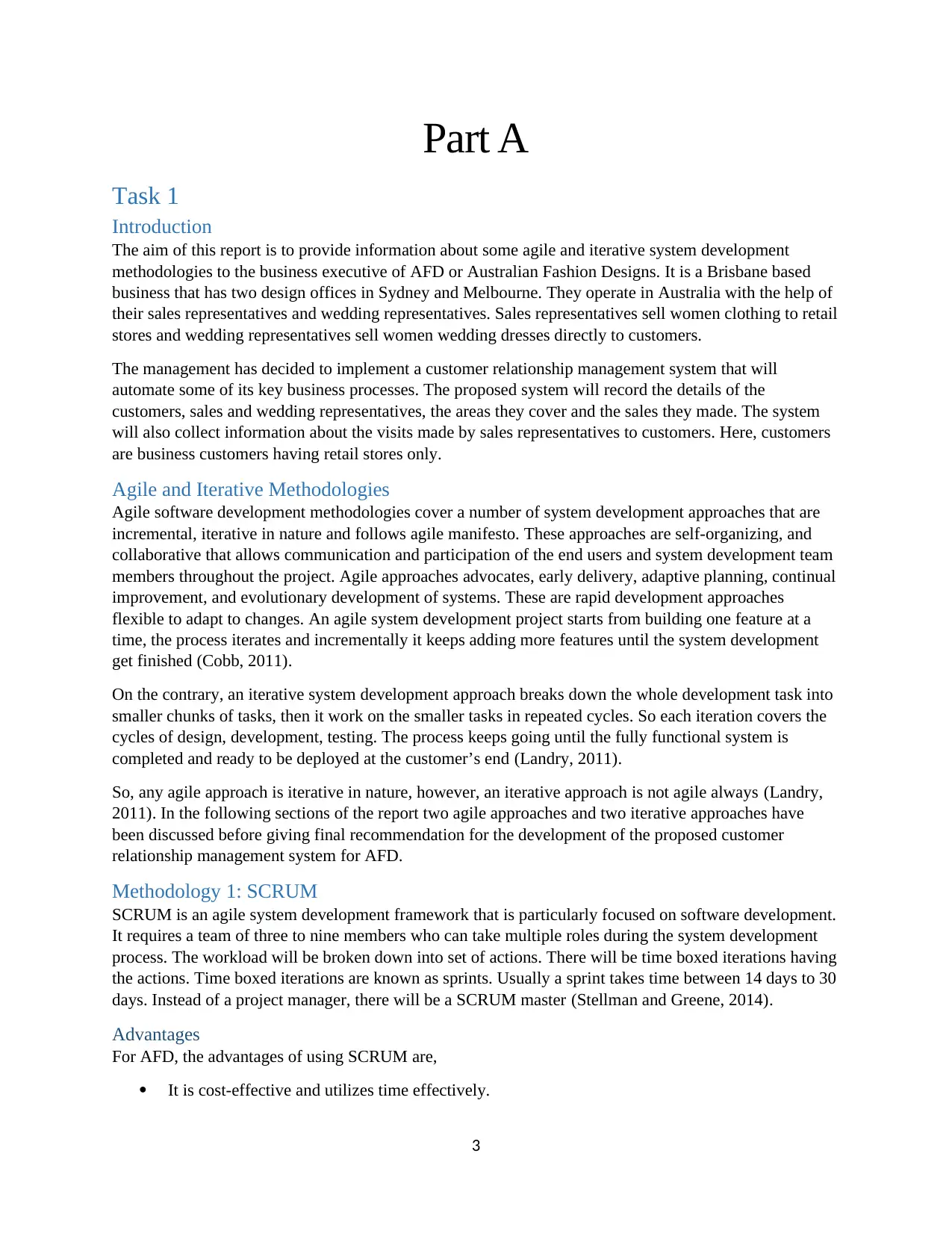
Part A
Task 1
Introduction
The aim of this report is to provide information about some agile and iterative system development
methodologies to the business executive of AFD or Australian Fashion Designs. It is a Brisbane based
business that has two design offices in Sydney and Melbourne. They operate in Australia with the help of
their sales representatives and wedding representatives. Sales representatives sell women clothing to retail
stores and wedding representatives sell women wedding dresses directly to customers.
The management has decided to implement a customer relationship management system that will
automate some of its key business processes. The proposed system will record the details of the
customers, sales and wedding representatives, the areas they cover and the sales they made. The system
will also collect information about the visits made by sales representatives to customers. Here, customers
are business customers having retail stores only.
Agile and Iterative Methodologies
Agile software development methodologies cover a number of system development approaches that are
incremental, iterative in nature and follows agile manifesto. These approaches are self-organizing, and
collaborative that allows communication and participation of the end users and system development team
members throughout the project. Agile approaches advocates, early delivery, adaptive planning, continual
improvement, and evolutionary development of systems. These are rapid development approaches
flexible to adapt to changes. An agile system development project starts from building one feature at a
time, the process iterates and incrementally it keeps adding more features until the system development
get finished (Cobb, 2011).
On the contrary, an iterative system development approach breaks down the whole development task into
smaller chunks of tasks, then it work on the smaller tasks in repeated cycles. So each iteration covers the
cycles of design, development, testing. The process keeps going until the fully functional system is
completed and ready to be deployed at the customer’s end (Landry, 2011).
So, any agile approach is iterative in nature, however, an iterative approach is not agile always (Landry,
2011). In the following sections of the report two agile approaches and two iterative approaches have
been discussed before giving final recommendation for the development of the proposed customer
relationship management system for AFD.
Methodology 1: SCRUM
SCRUM is an agile system development framework that is particularly focused on software development.
It requires a team of three to nine members who can take multiple roles during the system development
process. The workload will be broken down into set of actions. There will be time boxed iterations having
the actions. Time boxed iterations are known as sprints. Usually a sprint takes time between 14 days to 30
days. Instead of a project manager, there will be a SCRUM master (Stellman and Greene, 2014).
Advantages
For AFD, the advantages of using SCRUM are,
It is cost-effective and utilizes time effectively.
3
Task 1
Introduction
The aim of this report is to provide information about some agile and iterative system development
methodologies to the business executive of AFD or Australian Fashion Designs. It is a Brisbane based
business that has two design offices in Sydney and Melbourne. They operate in Australia with the help of
their sales representatives and wedding representatives. Sales representatives sell women clothing to retail
stores and wedding representatives sell women wedding dresses directly to customers.
The management has decided to implement a customer relationship management system that will
automate some of its key business processes. The proposed system will record the details of the
customers, sales and wedding representatives, the areas they cover and the sales they made. The system
will also collect information about the visits made by sales representatives to customers. Here, customers
are business customers having retail stores only.
Agile and Iterative Methodologies
Agile software development methodologies cover a number of system development approaches that are
incremental, iterative in nature and follows agile manifesto. These approaches are self-organizing, and
collaborative that allows communication and participation of the end users and system development team
members throughout the project. Agile approaches advocates, early delivery, adaptive planning, continual
improvement, and evolutionary development of systems. These are rapid development approaches
flexible to adapt to changes. An agile system development project starts from building one feature at a
time, the process iterates and incrementally it keeps adding more features until the system development
get finished (Cobb, 2011).
On the contrary, an iterative system development approach breaks down the whole development task into
smaller chunks of tasks, then it work on the smaller tasks in repeated cycles. So each iteration covers the
cycles of design, development, testing. The process keeps going until the fully functional system is
completed and ready to be deployed at the customer’s end (Landry, 2011).
So, any agile approach is iterative in nature, however, an iterative approach is not agile always (Landry,
2011). In the following sections of the report two agile approaches and two iterative approaches have
been discussed before giving final recommendation for the development of the proposed customer
relationship management system for AFD.
Methodology 1: SCRUM
SCRUM is an agile system development framework that is particularly focused on software development.
It requires a team of three to nine members who can take multiple roles during the system development
process. The workload will be broken down into set of actions. There will be time boxed iterations having
the actions. Time boxed iterations are known as sprints. Usually a sprint takes time between 14 days to 30
days. Instead of a project manager, there will be a SCRUM master (Stellman and Greene, 2014).
Advantages
For AFD, the advantages of using SCRUM are,
It is cost-effective and utilizes time effectively.
3
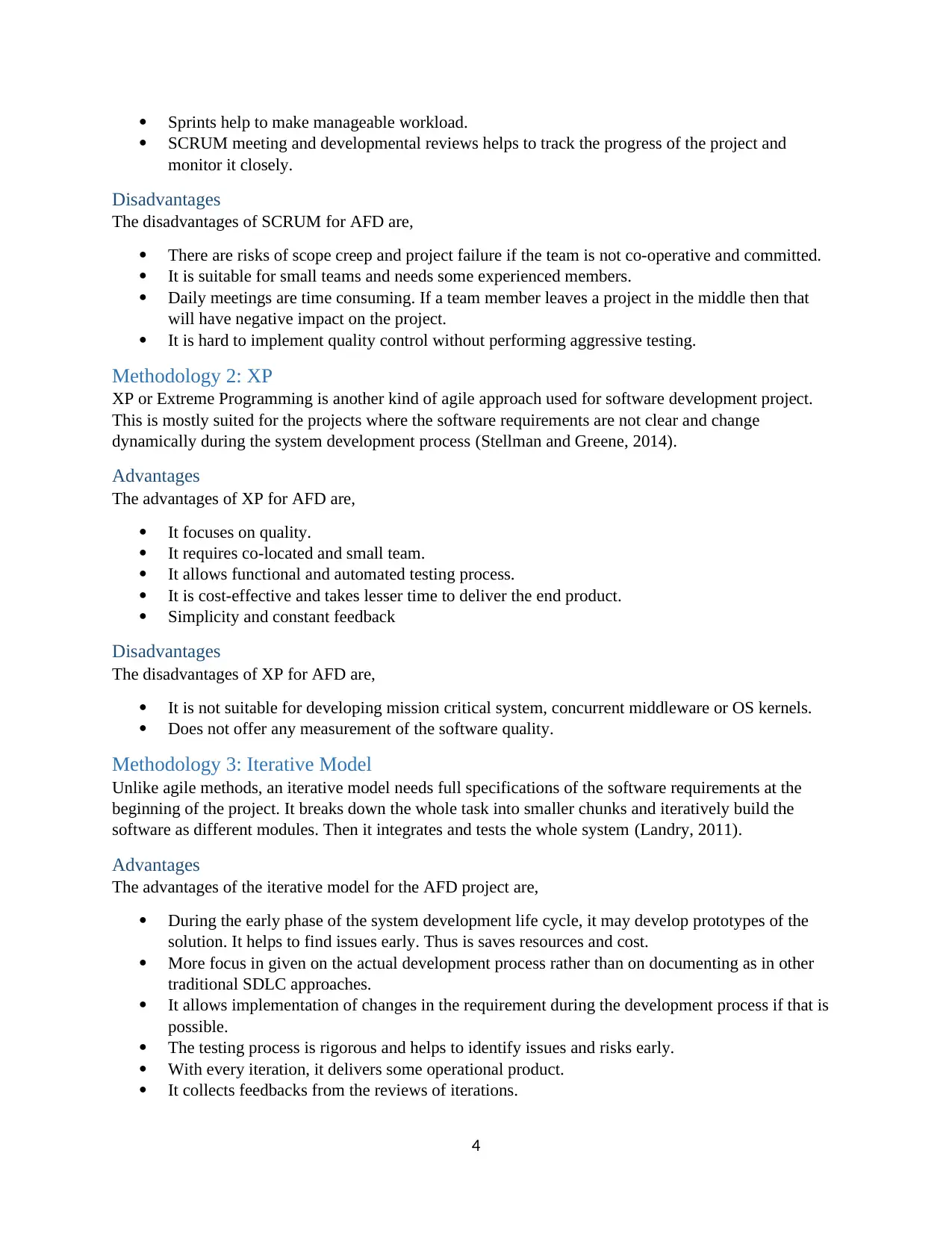
Sprints help to make manageable workload.
SCRUM meeting and developmental reviews helps to track the progress of the project and
monitor it closely.
Disadvantages
The disadvantages of SCRUM for AFD are,
There are risks of scope creep and project failure if the team is not co-operative and committed.
It is suitable for small teams and needs some experienced members.
Daily meetings are time consuming. If a team member leaves a project in the middle then that
will have negative impact on the project.
It is hard to implement quality control without performing aggressive testing.
Methodology 2: XP
XP or Extreme Programming is another kind of agile approach used for software development project.
This is mostly suited for the projects where the software requirements are not clear and change
dynamically during the system development process (Stellman and Greene, 2014).
Advantages
The advantages of XP for AFD are,
It focuses on quality.
It requires co-located and small team.
It allows functional and automated testing process.
It is cost-effective and takes lesser time to deliver the end product.
Simplicity and constant feedback
Disadvantages
The disadvantages of XP for AFD are,
It is not suitable for developing mission critical system, concurrent middleware or OS kernels.
Does not offer any measurement of the software quality.
Methodology 3: Iterative Model
Unlike agile methods, an iterative model needs full specifications of the software requirements at the
beginning of the project. It breaks down the whole task into smaller chunks and iteratively build the
software as different modules. Then it integrates and tests the whole system (Landry, 2011).
Advantages
The advantages of the iterative model for the AFD project are,
During the early phase of the system development life cycle, it may develop prototypes of the
solution. It helps to find issues early. Thus is saves resources and cost.
More focus in given on the actual development process rather than on documenting as in other
traditional SDLC approaches.
It allows implementation of changes in the requirement during the development process if that is
possible.
The testing process is rigorous and helps to identify issues and risks early.
With every iteration, it delivers some operational product.
It collects feedbacks from the reviews of iterations.
4
SCRUM meeting and developmental reviews helps to track the progress of the project and
monitor it closely.
Disadvantages
The disadvantages of SCRUM for AFD are,
There are risks of scope creep and project failure if the team is not co-operative and committed.
It is suitable for small teams and needs some experienced members.
Daily meetings are time consuming. If a team member leaves a project in the middle then that
will have negative impact on the project.
It is hard to implement quality control without performing aggressive testing.
Methodology 2: XP
XP or Extreme Programming is another kind of agile approach used for software development project.
This is mostly suited for the projects where the software requirements are not clear and change
dynamically during the system development process (Stellman and Greene, 2014).
Advantages
The advantages of XP for AFD are,
It focuses on quality.
It requires co-located and small team.
It allows functional and automated testing process.
It is cost-effective and takes lesser time to deliver the end product.
Simplicity and constant feedback
Disadvantages
The disadvantages of XP for AFD are,
It is not suitable for developing mission critical system, concurrent middleware or OS kernels.
Does not offer any measurement of the software quality.
Methodology 3: Iterative Model
Unlike agile methods, an iterative model needs full specifications of the software requirements at the
beginning of the project. It breaks down the whole task into smaller chunks and iteratively build the
software as different modules. Then it integrates and tests the whole system (Landry, 2011).
Advantages
The advantages of the iterative model for the AFD project are,
During the early phase of the system development life cycle, it may develop prototypes of the
solution. It helps to find issues early. Thus is saves resources and cost.
More focus in given on the actual development process rather than on documenting as in other
traditional SDLC approaches.
It allows implementation of changes in the requirement during the development process if that is
possible.
The testing process is rigorous and helps to identify issues and risks early.
With every iteration, it delivers some operational product.
It collects feedbacks from the reviews of iterations.
4
Secure Best Marks with AI Grader
Need help grading? Try our AI Grader for instant feedback on your assignments.
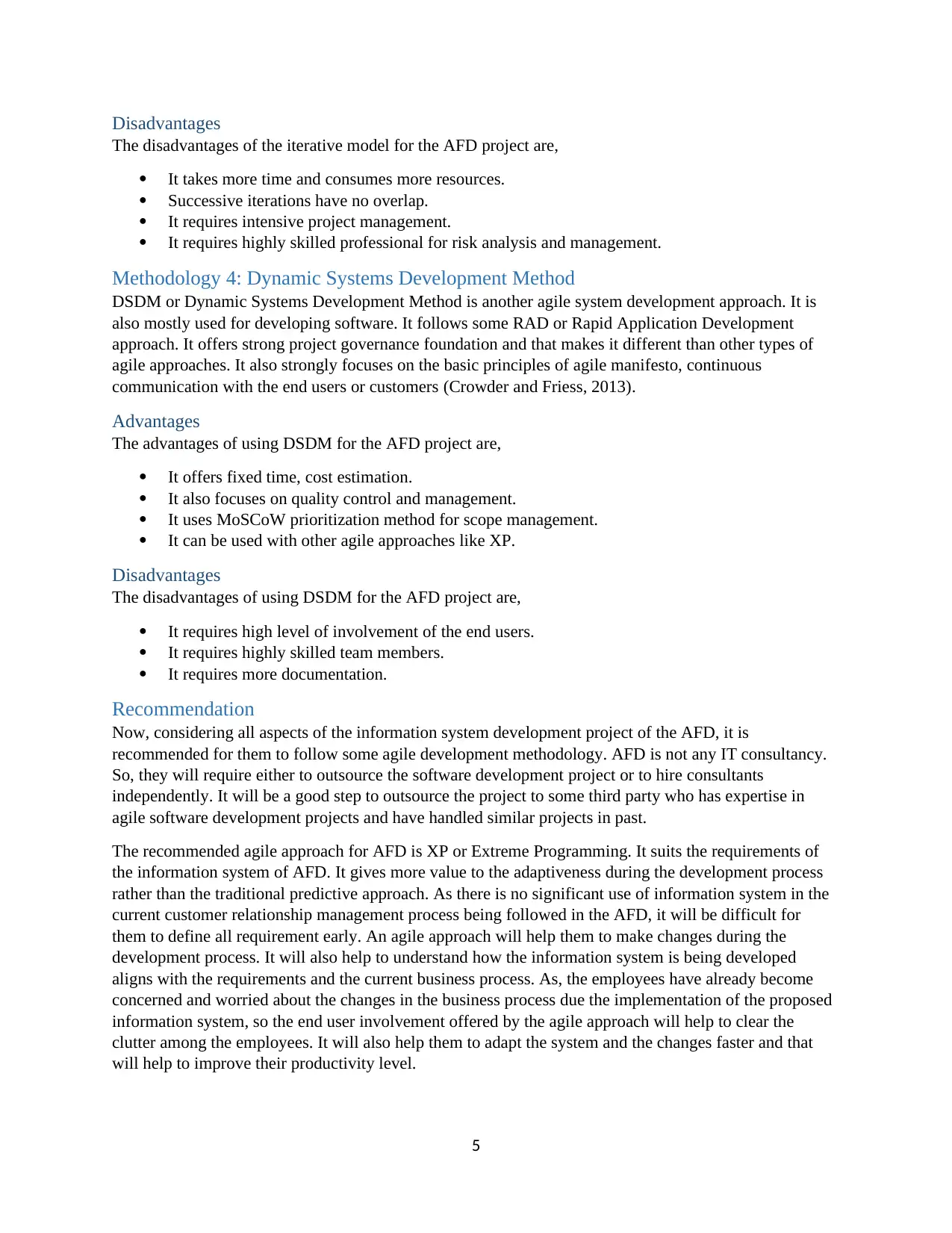
Disadvantages
The disadvantages of the iterative model for the AFD project are,
It takes more time and consumes more resources.
Successive iterations have no overlap.
It requires intensive project management.
It requires highly skilled professional for risk analysis and management.
Methodology 4: Dynamic Systems Development Method
DSDM or Dynamic Systems Development Method is another agile system development approach. It is
also mostly used for developing software. It follows some RAD or Rapid Application Development
approach. It offers strong project governance foundation and that makes it different than other types of
agile approaches. It also strongly focuses on the basic principles of agile manifesto, continuous
communication with the end users or customers (Crowder and Friess, 2013).
Advantages
The advantages of using DSDM for the AFD project are,
It offers fixed time, cost estimation.
It also focuses on quality control and management.
It uses MoSCoW prioritization method for scope management.
It can be used with other agile approaches like XP.
Disadvantages
The disadvantages of using DSDM for the AFD project are,
It requires high level of involvement of the end users.
It requires highly skilled team members.
It requires more documentation.
Recommendation
Now, considering all aspects of the information system development project of the AFD, it is
recommended for them to follow some agile development methodology. AFD is not any IT consultancy.
So, they will require either to outsource the software development project or to hire consultants
independently. It will be a good step to outsource the project to some third party who has expertise in
agile software development projects and have handled similar projects in past.
The recommended agile approach for AFD is XP or Extreme Programming. It suits the requirements of
the information system of AFD. It gives more value to the adaptiveness during the development process
rather than the traditional predictive approach. As there is no significant use of information system in the
current customer relationship management process being followed in the AFD, it will be difficult for
them to define all requirement early. An agile approach will help them to make changes during the
development process. It will also help to understand how the information system is being developed
aligns with the requirements and the current business process. As, the employees have already become
concerned and worried about the changes in the business process due the implementation of the proposed
information system, so the end user involvement offered by the agile approach will help to clear the
clutter among the employees. It will also help them to adapt the system and the changes faster and that
will help to improve their productivity level.
5
The disadvantages of the iterative model for the AFD project are,
It takes more time and consumes more resources.
Successive iterations have no overlap.
It requires intensive project management.
It requires highly skilled professional for risk analysis and management.
Methodology 4: Dynamic Systems Development Method
DSDM or Dynamic Systems Development Method is another agile system development approach. It is
also mostly used for developing software. It follows some RAD or Rapid Application Development
approach. It offers strong project governance foundation and that makes it different than other types of
agile approaches. It also strongly focuses on the basic principles of agile manifesto, continuous
communication with the end users or customers (Crowder and Friess, 2013).
Advantages
The advantages of using DSDM for the AFD project are,
It offers fixed time, cost estimation.
It also focuses on quality control and management.
It uses MoSCoW prioritization method for scope management.
It can be used with other agile approaches like XP.
Disadvantages
The disadvantages of using DSDM for the AFD project are,
It requires high level of involvement of the end users.
It requires highly skilled team members.
It requires more documentation.
Recommendation
Now, considering all aspects of the information system development project of the AFD, it is
recommended for them to follow some agile development methodology. AFD is not any IT consultancy.
So, they will require either to outsource the software development project or to hire consultants
independently. It will be a good step to outsource the project to some third party who has expertise in
agile software development projects and have handled similar projects in past.
The recommended agile approach for AFD is XP or Extreme Programming. It suits the requirements of
the information system of AFD. It gives more value to the adaptiveness during the development process
rather than the traditional predictive approach. As there is no significant use of information system in the
current customer relationship management process being followed in the AFD, it will be difficult for
them to define all requirement early. An agile approach will help them to make changes during the
development process. It will also help to understand how the information system is being developed
aligns with the requirements and the current business process. As, the employees have already become
concerned and worried about the changes in the business process due the implementation of the proposed
information system, so the end user involvement offered by the agile approach will help to clear the
clutter among the employees. It will also help them to adapt the system and the changes faster and that
will help to improve their productivity level.
5
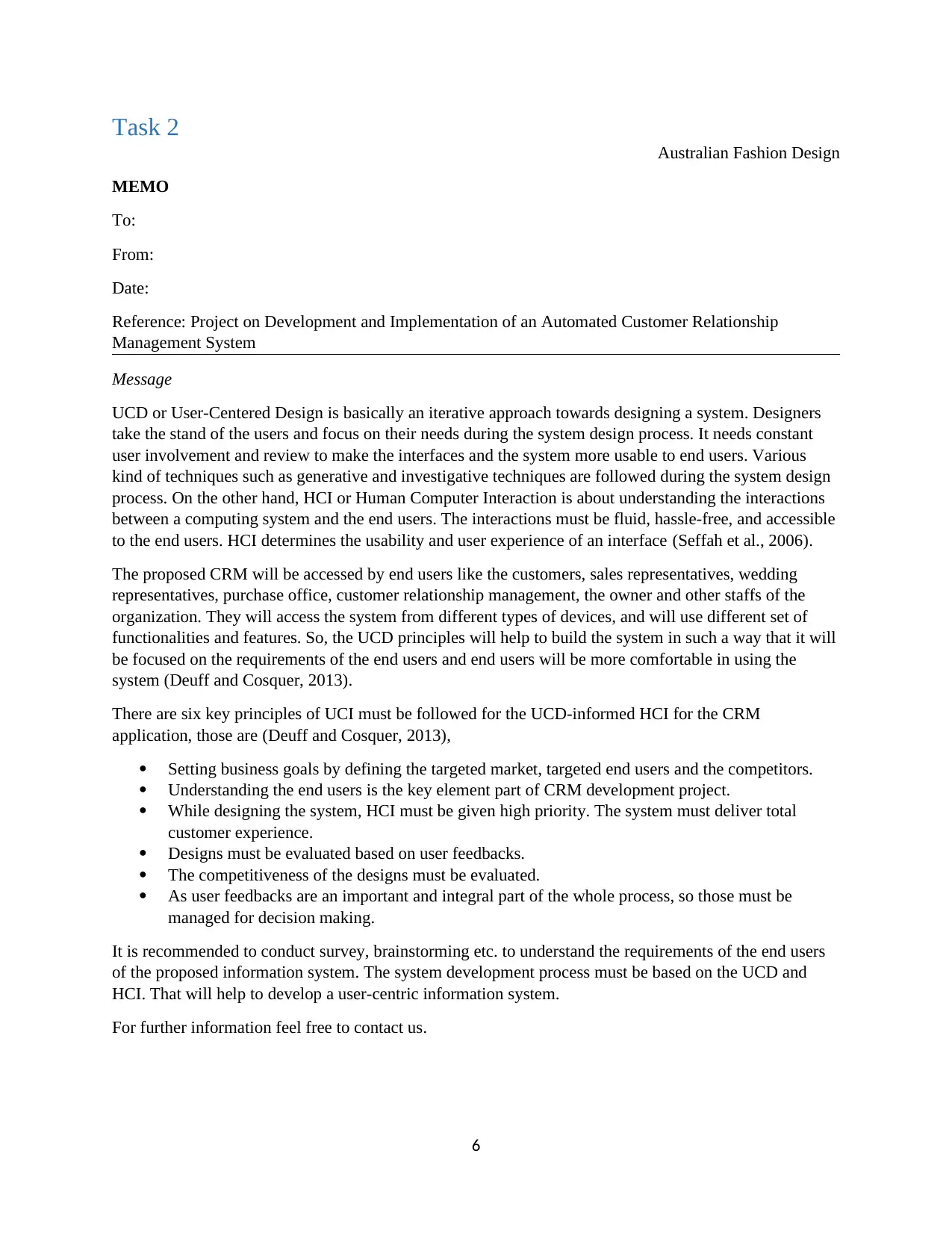
Task 2 Australian Fashion Design
MEMO
To:
From:
Date:
Reference: Project on Development and Implementation of an Automated Customer Relationship
Management System
Message
UCD or User-Centered Design is basically an iterative approach towards designing a system. Designers
take the stand of the users and focus on their needs during the system design process. It needs constant
user involvement and review to make the interfaces and the system more usable to end users. Various
kind of techniques such as generative and investigative techniques are followed during the system design
process. On the other hand, HCI or Human Computer Interaction is about understanding the interactions
between a computing system and the end users. The interactions must be fluid, hassle-free, and accessible
to the end users. HCI determines the usability and user experience of an interface (Seffah et al., 2006).
The proposed CRM will be accessed by end users like the customers, sales representatives, wedding
representatives, purchase office, customer relationship management, the owner and other staffs of the
organization. They will access the system from different types of devices, and will use different set of
functionalities and features. So, the UCD principles will help to build the system in such a way that it will
be focused on the requirements of the end users and end users will be more comfortable in using the
system (Deuff and Cosquer, 2013).
There are six key principles of UCI must be followed for the UCD-informed HCI for the CRM
application, those are (Deuff and Cosquer, 2013),
Setting business goals by defining the targeted market, targeted end users and the competitors.
Understanding the end users is the key element part of CRM development project.
While designing the system, HCI must be given high priority. The system must deliver total
customer experience.
Designs must be evaluated based on user feedbacks.
The competitiveness of the designs must be evaluated.
As user feedbacks are an important and integral part of the whole process, so those must be
managed for decision making.
It is recommended to conduct survey, brainstorming etc. to understand the requirements of the end users
of the proposed information system. The system development process must be based on the UCD and
HCI. That will help to develop a user-centric information system.
For further information feel free to contact us.
6
MEMO
To:
From:
Date:
Reference: Project on Development and Implementation of an Automated Customer Relationship
Management System
Message
UCD or User-Centered Design is basically an iterative approach towards designing a system. Designers
take the stand of the users and focus on their needs during the system design process. It needs constant
user involvement and review to make the interfaces and the system more usable to end users. Various
kind of techniques such as generative and investigative techniques are followed during the system design
process. On the other hand, HCI or Human Computer Interaction is about understanding the interactions
between a computing system and the end users. The interactions must be fluid, hassle-free, and accessible
to the end users. HCI determines the usability and user experience of an interface (Seffah et al., 2006).
The proposed CRM will be accessed by end users like the customers, sales representatives, wedding
representatives, purchase office, customer relationship management, the owner and other staffs of the
organization. They will access the system from different types of devices, and will use different set of
functionalities and features. So, the UCD principles will help to build the system in such a way that it will
be focused on the requirements of the end users and end users will be more comfortable in using the
system (Deuff and Cosquer, 2013).
There are six key principles of UCI must be followed for the UCD-informed HCI for the CRM
application, those are (Deuff and Cosquer, 2013),
Setting business goals by defining the targeted market, targeted end users and the competitors.
Understanding the end users is the key element part of CRM development project.
While designing the system, HCI must be given high priority. The system must deliver total
customer experience.
Designs must be evaluated based on user feedbacks.
The competitiveness of the designs must be evaluated.
As user feedbacks are an important and integral part of the whole process, so those must be
managed for decision making.
It is recommended to conduct survey, brainstorming etc. to understand the requirements of the end users
of the proposed information system. The system development process must be based on the UCD and
HCI. That will help to develop a user-centric information system.
For further information feel free to contact us.
6
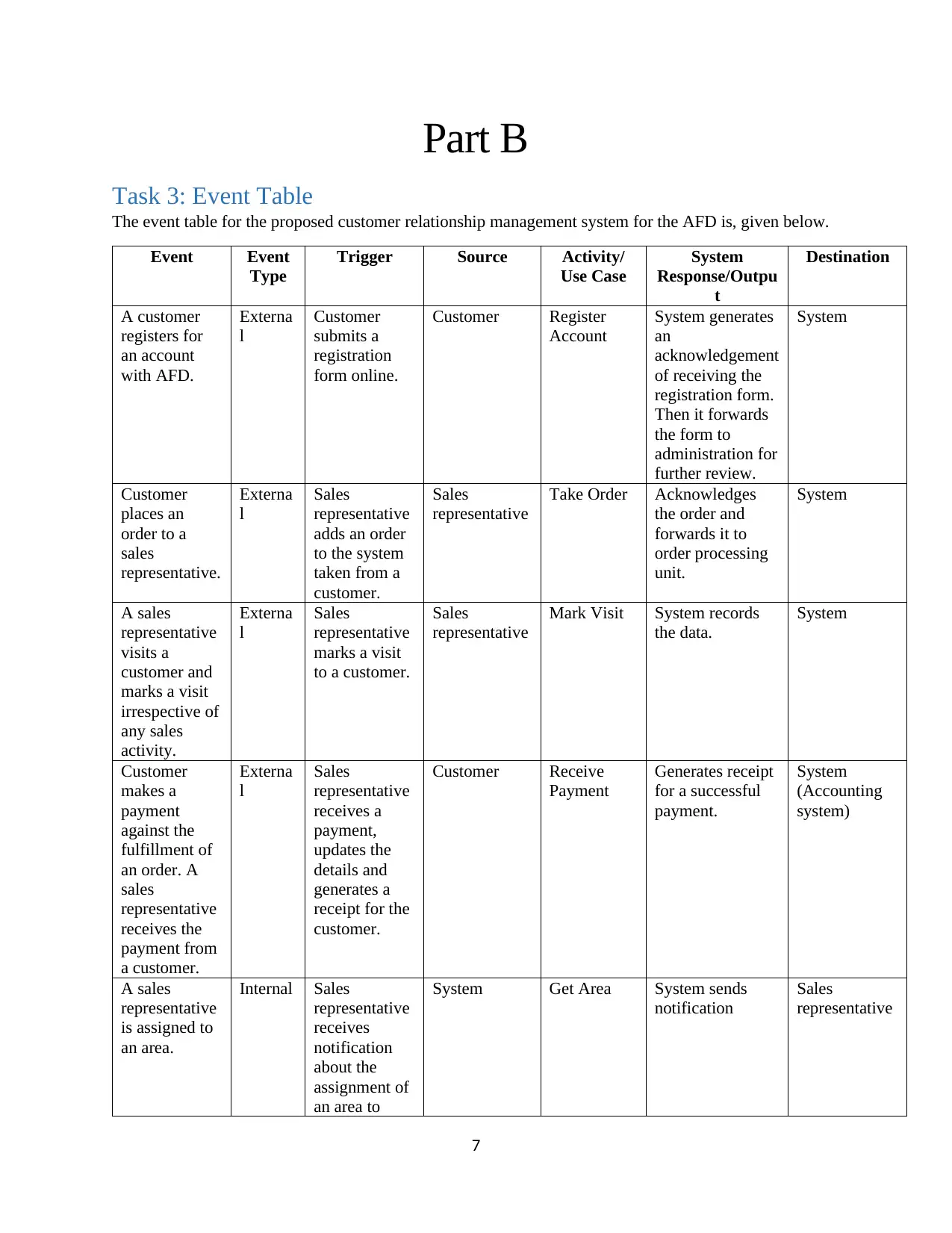
Part B
Task 3: Event Table
The event table for the proposed customer relationship management system for the AFD is, given below.
Event Event
Type
Trigger Source Activity/
Use Case
System
Response/Outpu
t
Destination
A customer
registers for
an account
with AFD.
Externa
l
Customer
submits a
registration
form online.
Customer Register
Account
System generates
an
acknowledgement
of receiving the
registration form.
Then it forwards
the form to
administration for
further review.
System
Customer
places an
order to a
sales
representative.
Externa
l
Sales
representative
adds an order
to the system
taken from a
customer.
Sales
representative
Take Order Acknowledges
the order and
forwards it to
order processing
unit.
System
A sales
representative
visits a
customer and
marks a visit
irrespective of
any sales
activity.
Externa
l
Sales
representative
marks a visit
to a customer.
Sales
representative
Mark Visit System records
the data.
System
Customer
makes a
payment
against the
fulfillment of
an order. A
sales
representative
receives the
payment from
a customer.
Externa
l
Sales
representative
receives a
payment,
updates the
details and
generates a
receipt for the
customer.
Customer Receive
Payment
Generates receipt
for a successful
payment.
System
(Accounting
system)
A sales
representative
is assigned to
an area.
Internal Sales
representative
receives
notification
about the
assignment of
an area to
System Get Area System sends
notification
Sales
representative
7
Task 3: Event Table
The event table for the proposed customer relationship management system for the AFD is, given below.
Event Event
Type
Trigger Source Activity/
Use Case
System
Response/Outpu
t
Destination
A customer
registers for
an account
with AFD.
Externa
l
Customer
submits a
registration
form online.
Customer Register
Account
System generates
an
acknowledgement
of receiving the
registration form.
Then it forwards
the form to
administration for
further review.
System
Customer
places an
order to a
sales
representative.
Externa
l
Sales
representative
adds an order
to the system
taken from a
customer.
Sales
representative
Take Order Acknowledges
the order and
forwards it to
order processing
unit.
System
A sales
representative
visits a
customer and
marks a visit
irrespective of
any sales
activity.
Externa
l
Sales
representative
marks a visit
to a customer.
Sales
representative
Mark Visit System records
the data.
System
Customer
makes a
payment
against the
fulfillment of
an order. A
sales
representative
receives the
payment from
a customer.
Externa
l
Sales
representative
receives a
payment,
updates the
details and
generates a
receipt for the
customer.
Customer Receive
Payment
Generates receipt
for a successful
payment.
System
(Accounting
system)
A sales
representative
is assigned to
an area.
Internal Sales
representative
receives
notification
about the
assignment of
an area to
System Get Area System sends
notification
Sales
representative
7
Paraphrase This Document
Need a fresh take? Get an instant paraphrase of this document with our AI Paraphraser
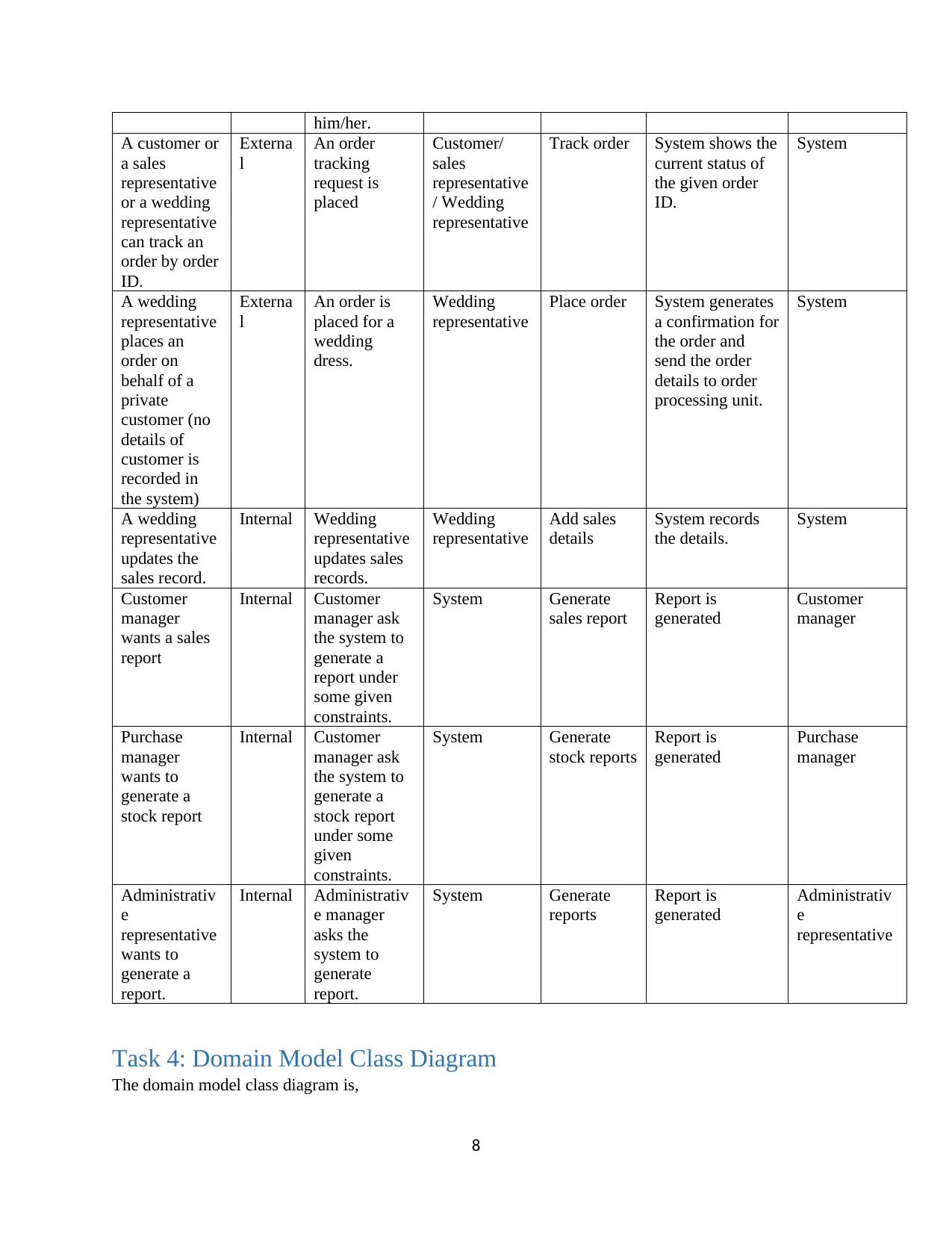
him/her.
A customer or
a sales
representative
or a wedding
representative
can track an
order by order
ID.
Externa
l
An order
tracking
request is
placed
Customer/
sales
representative
/ Wedding
representative
Track order System shows the
current status of
the given order
ID.
System
A wedding
representative
places an
order on
behalf of a
private
customer (no
details of
customer is
recorded in
the system)
Externa
l
An order is
placed for a
wedding
dress.
Wedding
representative
Place order System generates
a confirmation for
the order and
send the order
details to order
processing unit.
System
A wedding
representative
updates the
sales record.
Internal Wedding
representative
updates sales
records.
Wedding
representative
Add sales
details
System records
the details.
System
Customer
manager
wants a sales
report
Internal Customer
manager ask
the system to
generate a
report under
some given
constraints.
System Generate
sales report
Report is
generated
Customer
manager
Purchase
manager
wants to
generate a
stock report
Internal Customer
manager ask
the system to
generate a
stock report
under some
given
constraints.
System Generate
stock reports
Report is
generated
Purchase
manager
Administrativ
e
representative
wants to
generate a
report.
Internal Administrativ
e manager
asks the
system to
generate
report.
System Generate
reports
Report is
generated
Administrativ
e
representative
Task 4: Domain Model Class Diagram
The domain model class diagram is,
8
A customer or
a sales
representative
or a wedding
representative
can track an
order by order
ID.
Externa
l
An order
tracking
request is
placed
Customer/
sales
representative
/ Wedding
representative
Track order System shows the
current status of
the given order
ID.
System
A wedding
representative
places an
order on
behalf of a
private
customer (no
details of
customer is
recorded in
the system)
Externa
l
An order is
placed for a
wedding
dress.
Wedding
representative
Place order System generates
a confirmation for
the order and
send the order
details to order
processing unit.
System
A wedding
representative
updates the
sales record.
Internal Wedding
representative
updates sales
records.
Wedding
representative
Add sales
details
System records
the details.
System
Customer
manager
wants a sales
report
Internal Customer
manager ask
the system to
generate a
report under
some given
constraints.
System Generate
sales report
Report is
generated
Customer
manager
Purchase
manager
wants to
generate a
stock report
Internal Customer
manager ask
the system to
generate a
stock report
under some
given
constraints.
System Generate
stock reports
Report is
generated
Purchase
manager
Administrativ
e
representative
wants to
generate a
report.
Internal Administrativ
e manager
asks the
system to
generate
report.
System Generate
reports
Report is
generated
Administrativ
e
representative
Task 4: Domain Model Class Diagram
The domain model class diagram is,
8
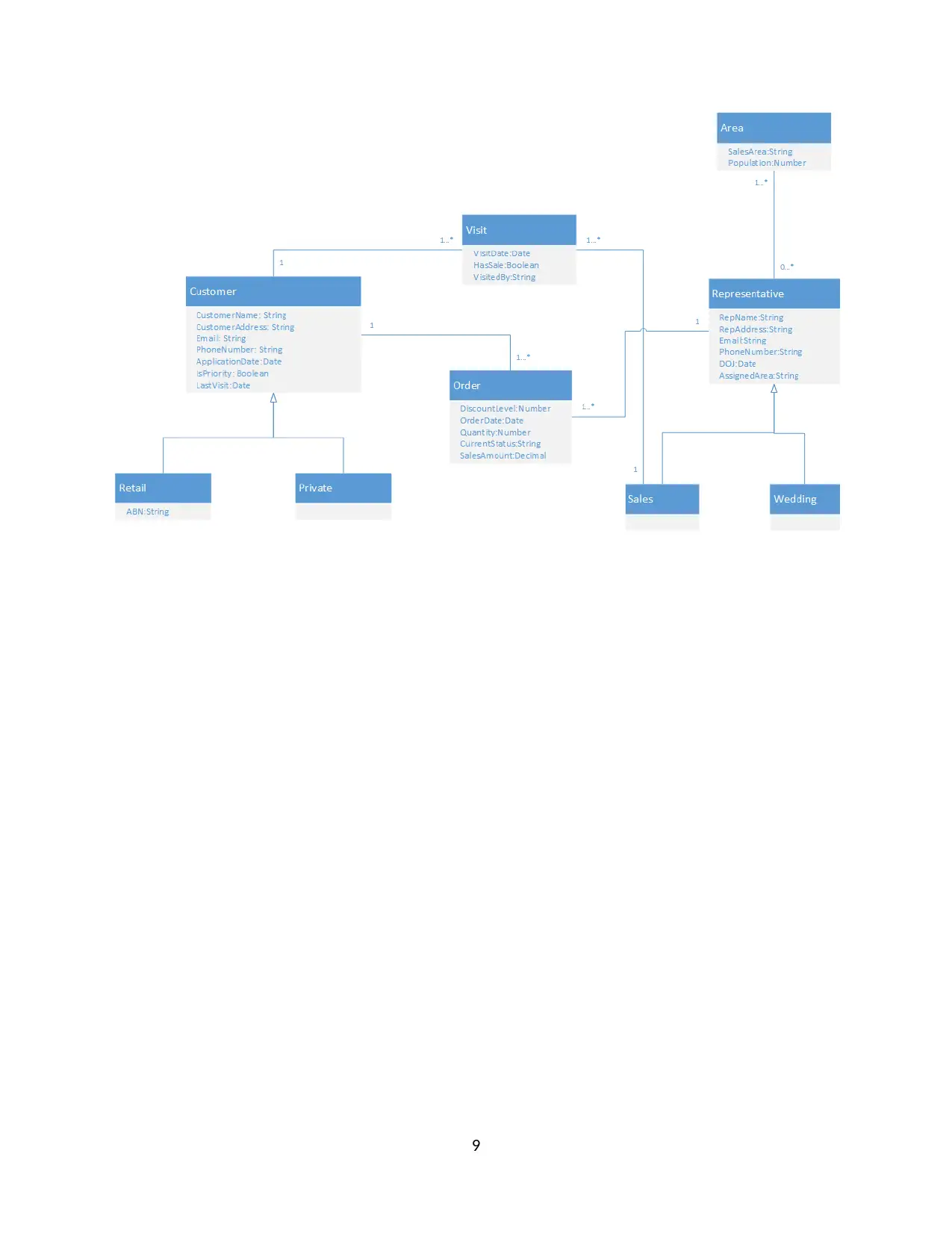
9
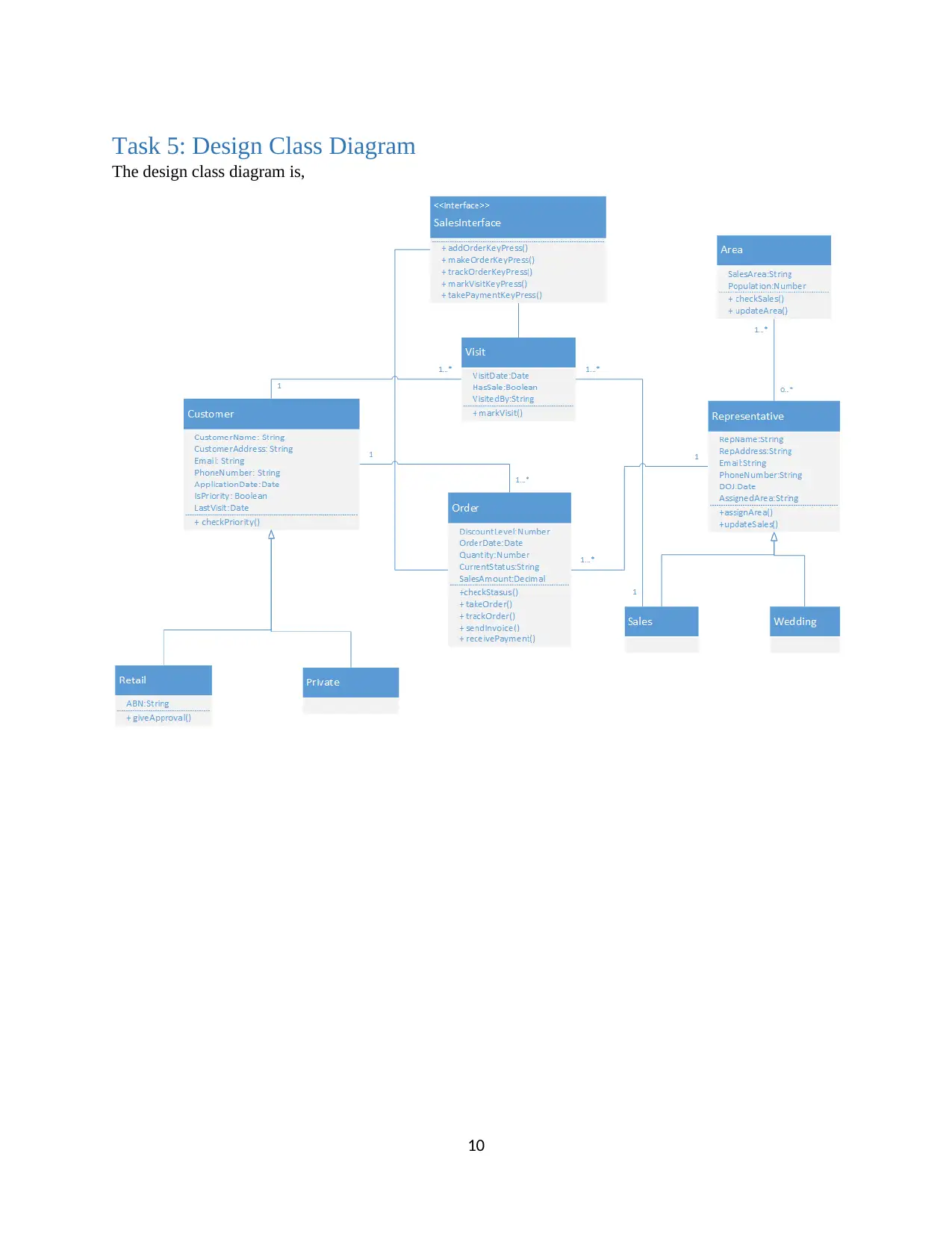
Task 5: Design Class Diagram
The design class diagram is,
10
The design class diagram is,
10
Secure Best Marks with AI Grader
Need help grading? Try our AI Grader for instant feedback on your assignments.
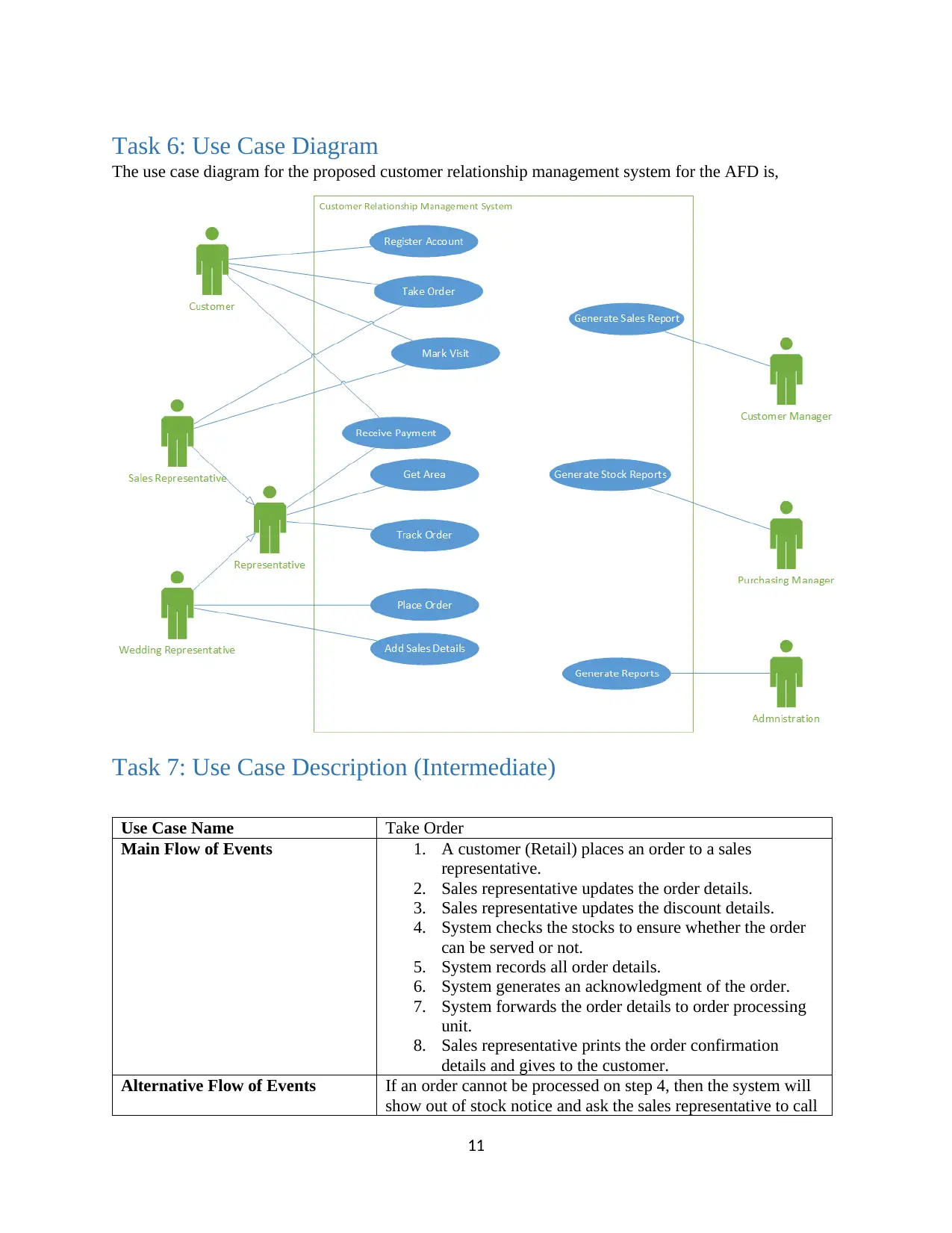
Task 6: Use Case Diagram
The use case diagram for the proposed customer relationship management system for the AFD is,
Task 7: Use Case Description (Intermediate)
Use Case Name Take Order
Main Flow of Events 1. A customer (Retail) places an order to a sales
representative.
2. Sales representative updates the order details.
3. Sales representative updates the discount details.
4. System checks the stocks to ensure whether the order
can be served or not.
5. System records all order details.
6. System generates an acknowledgment of the order.
7. System forwards the order details to order processing
unit.
8. Sales representative prints the order confirmation
details and gives to the customer.
Alternative Flow of Events If an order cannot be processed on step 4, then the system will
show out of stock notice and ask the sales representative to call
11
The use case diagram for the proposed customer relationship management system for the AFD is,
Task 7: Use Case Description (Intermediate)
Use Case Name Take Order
Main Flow of Events 1. A customer (Retail) places an order to a sales
representative.
2. Sales representative updates the order details.
3. Sales representative updates the discount details.
4. System checks the stocks to ensure whether the order
can be served or not.
5. System records all order details.
6. System generates an acknowledgment of the order.
7. System forwards the order details to order processing
unit.
8. Sales representative prints the order confirmation
details and gives to the customer.
Alternative Flow of Events If an order cannot be processed on step 4, then the system will
show out of stock notice and ask the sales representative to call
11
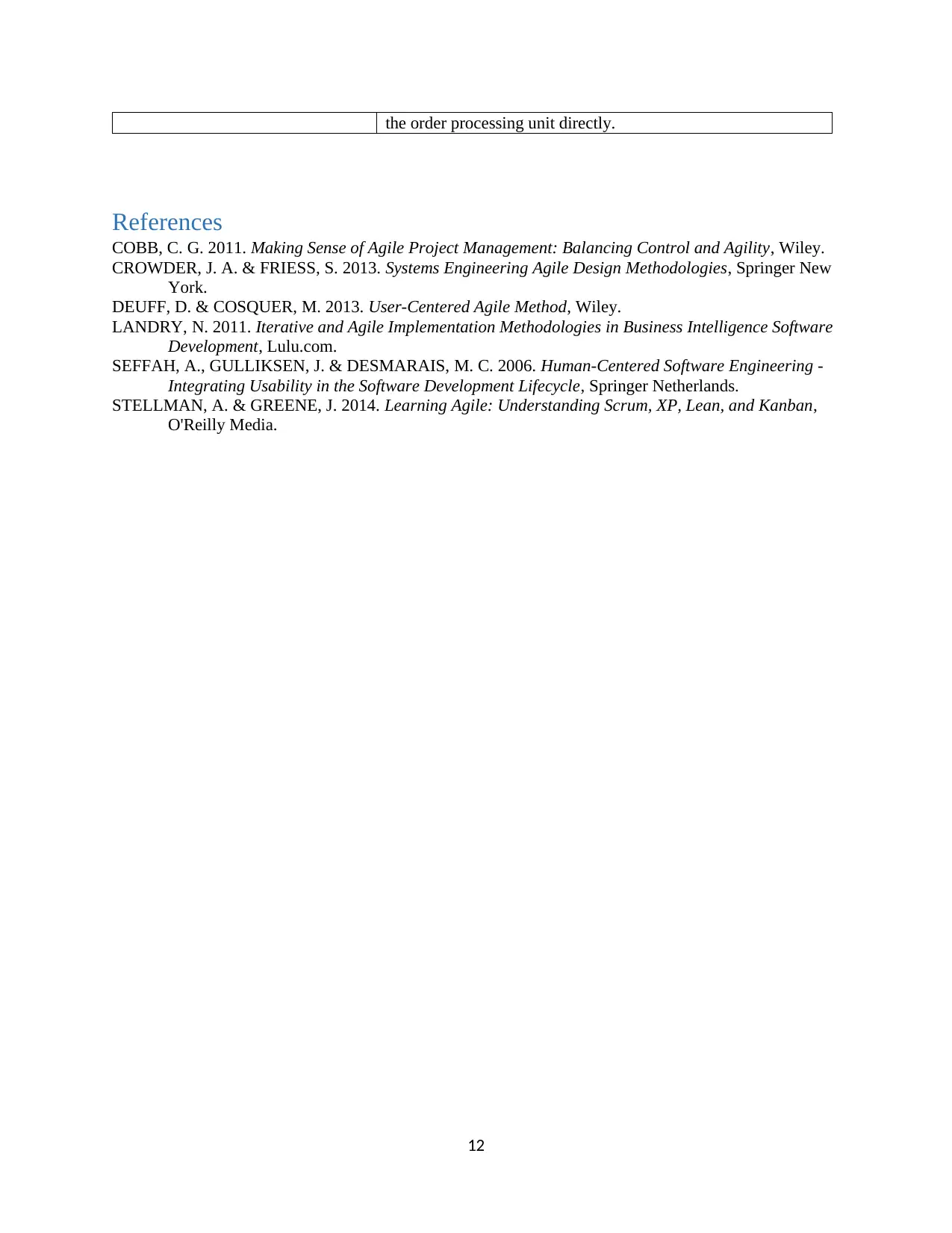
the order processing unit directly.
References
COBB, C. G. 2011. Making Sense of Agile Project Management: Balancing Control and Agility, Wiley.
CROWDER, J. A. & FRIESS, S. 2013. Systems Engineering Agile Design Methodologies, Springer New
York.
DEUFF, D. & COSQUER, M. 2013. User-Centered Agile Method, Wiley.
LANDRY, N. 2011. Iterative and Agile Implementation Methodologies in Business Intelligence Software
Development, Lulu.com.
SEFFAH, A., GULLIKSEN, J. & DESMARAIS, M. C. 2006. Human-Centered Software Engineering -
Integrating Usability in the Software Development Lifecycle, Springer Netherlands.
STELLMAN, A. & GREENE, J. 2014. Learning Agile: Understanding Scrum, XP, Lean, and Kanban,
O'Reilly Media.
12
References
COBB, C. G. 2011. Making Sense of Agile Project Management: Balancing Control and Agility, Wiley.
CROWDER, J. A. & FRIESS, S. 2013. Systems Engineering Agile Design Methodologies, Springer New
York.
DEUFF, D. & COSQUER, M. 2013. User-Centered Agile Method, Wiley.
LANDRY, N. 2011. Iterative and Agile Implementation Methodologies in Business Intelligence Software
Development, Lulu.com.
SEFFAH, A., GULLIKSEN, J. & DESMARAIS, M. C. 2006. Human-Centered Software Engineering -
Integrating Usability in the Software Development Lifecycle, Springer Netherlands.
STELLMAN, A. & GREENE, J. 2014. Learning Agile: Understanding Scrum, XP, Lean, and Kanban,
O'Reilly Media.
12
1 out of 12
Related Documents
Your All-in-One AI-Powered Toolkit for Academic Success.
+13062052269
info@desklib.com
Available 24*7 on WhatsApp / Email
![[object Object]](/_next/static/media/star-bottom.7253800d.svg)
Unlock your academic potential
© 2024 | Zucol Services PVT LTD | All rights reserved.




